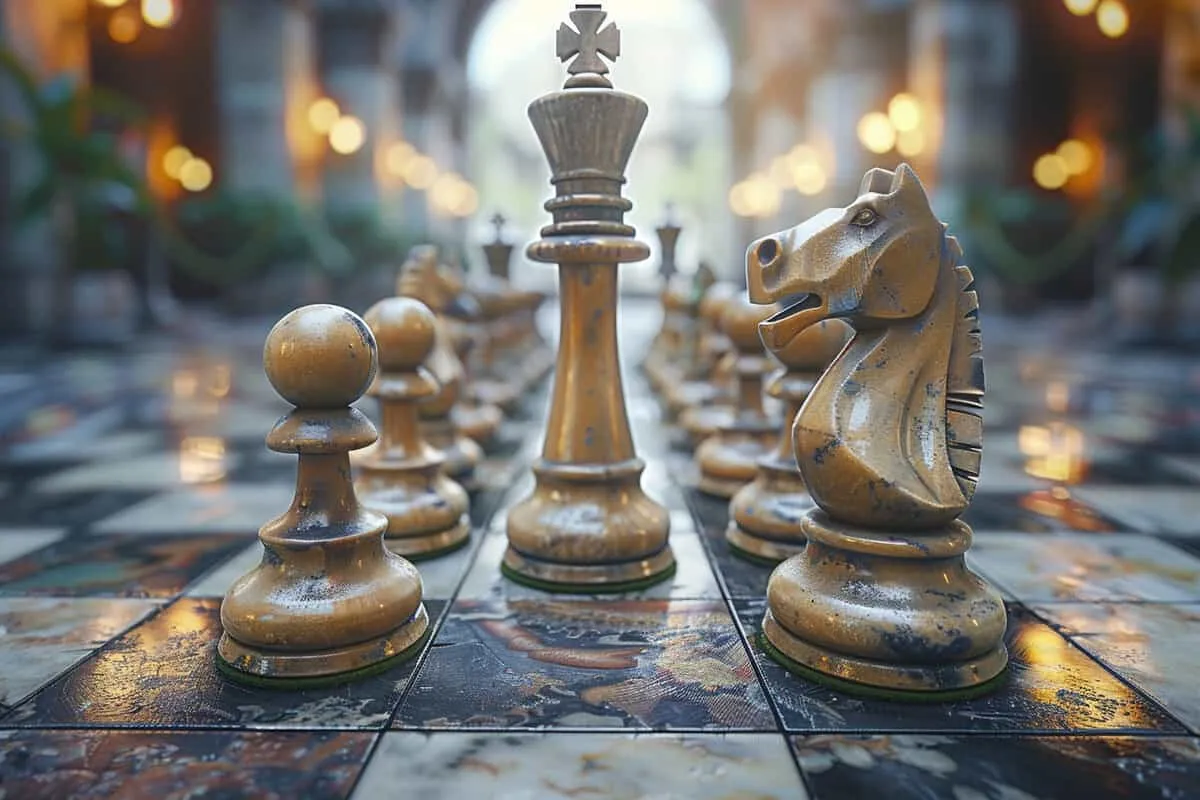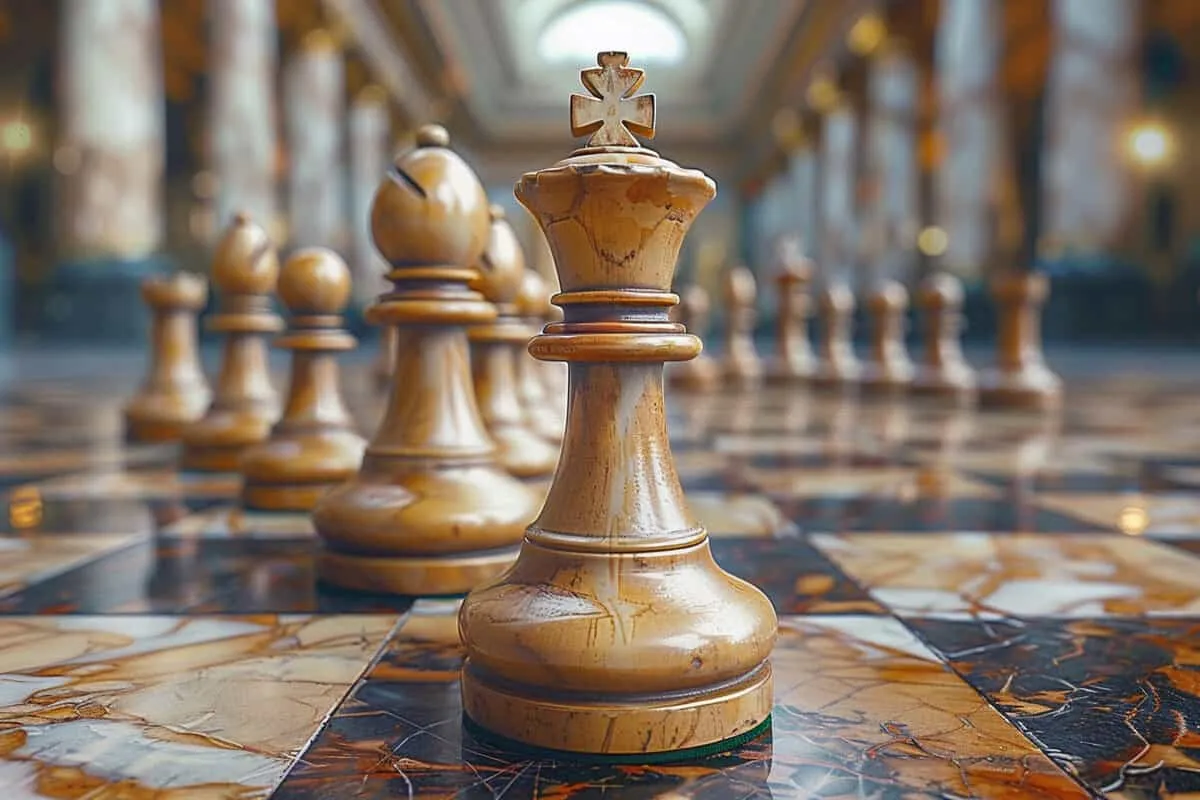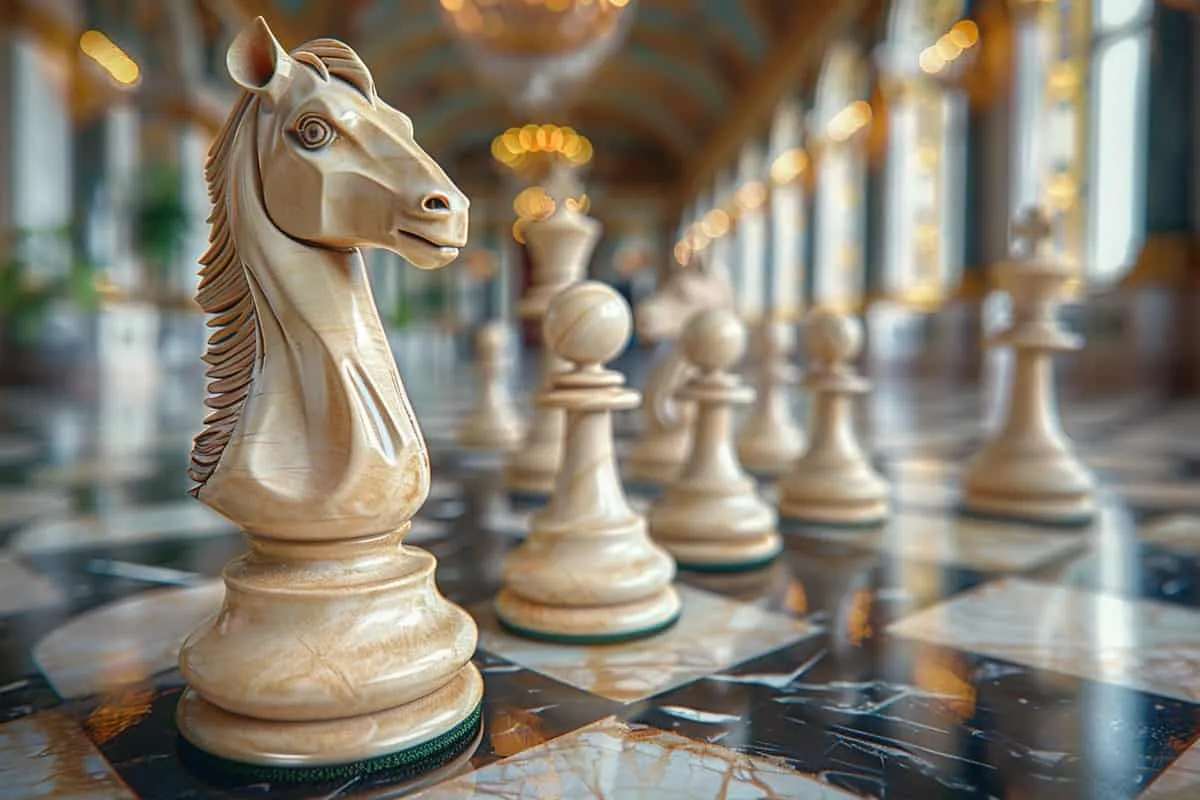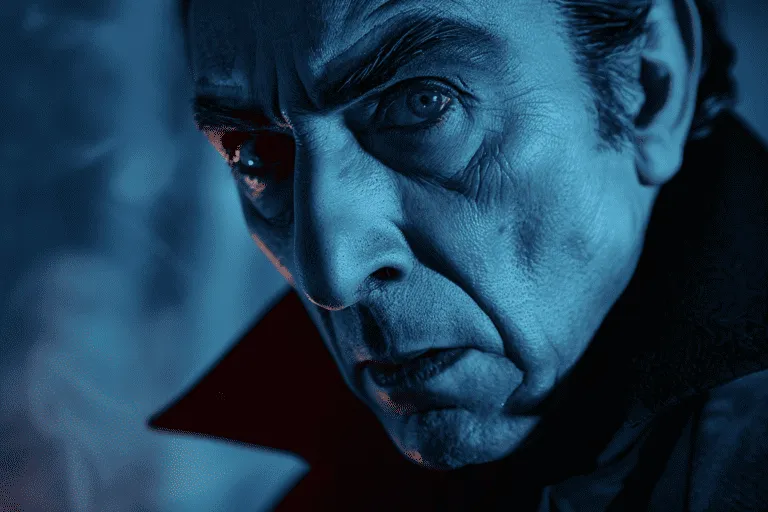10 Chess Facts (Surprising Insights into the Game’s History)
Chess isn’t just a game; it’s a universe of battles, strategies, and centuries-old secrets.
Imagine diving into the depths of this intellectual sport and uncovering facts that dazzle even the grandmasters.
From its ancient origins to record-breaking games, chess is packed with surprises that stretch beyond the 64 squares.
Whether you’re a casual player or an aspiring pro, these chess facts will give you a whole new appreciation for the game.
Ready to level up your chess trivia? Scroll down as we unveil our top picks that are sure to checkmate your curiosity.

1. The Origin of Chess Dates Back to the 6th Century in India
Chess, a game that has captivated millions around the globe, finds its roots deep in history.
It all started in India during the 6th century with a game called “Chaturanga.” This wasn’t just any board game; it was a strategic battlefield where each piece represented different units of an army.
Over time, Chaturanga evolved significantly. As traders and conquerors traveled from India to Persia, they brought this fascinating game with them. In Persia, it became known as “Shatranj,” marking its first step towards becoming the modern chess we know today.
The transformation didn’t stop there. When the Moors invaded Spain in the 8th century, chess made its way into Europe.
With each culture it touched, the game adapted and grew until it reached its current form.
One interesting chess fact tied to its evolution is how we got terms like “checkmate.”
The term comes from “Shah Mat,” which means “the king is helpless” in Persian. This reflects not only on chess’s rich history but also on how language evolves alongside games.
2. The Longest Possible Chess Game Can Last 5,949 Moves
Imagine playing a single chess match that spans days! According to the 50-move rule in chess, this is possible.
This rule states that if during the last 50 moves no pawn has been moved and no capture has occurred, a draw can be claimed by either player.
Based on this, the theoretical maximum length of a chess game stretches to an astounding 5,949 moves.
Why such a specific number? It’s all about maximizing each piece’s potential before claiming a draw under the 50-move rule.
Each pawn could theoretically move forward and eventually promote to a more powerful piece like a queen or rook, adding layers of complexity and extending the game significantly.
However, reaching this milestone is more of academic interest than practical reality. Most competitive or casual games conclude long before hitting even close to this mark.
The reasons are clear: players either achieve checkmate, agree to a draw based on repetition, or insufficient material for checkmate long before reaching thousands of moves.
Here are some quick points:
- Theoretical Maximum: A fascinating aspect for those who study chess deeply.
- Rarely Achieved: More common in hypothetical discussions than actual play.
- Based on Rules: Specifically leverages the 50-move rule for its basis.
3. The First Chessboard with Alternating Light and Dark Squares Appeared in Europe in 1090
In the year 1090, a significant change happened that would forever alter how chess is played. A new design for the chess board was introduced, featuring alternating light and dark squares.
This wasn’t just for looks; it had a big purpose.
The contrasting colors of the squares made it easier for players to see their pieces and plan their moves.
Before this, all squares were the same color which could make tracking each piece’s position more challenging, especially in dim lighting.
This innovation didn’t stay hidden or exclusive for long. It quickly became the standard worldwide, marking a pivotal moment in the evolution of chessboard design.
Today, every official game is played on this type of board – it’s hard to imagine playing without those distinct squares!
Why did this change catch on so fast? Simply put, it made games quicker and reduced errors caused by misseeing a move or piece placement. Players could focus more on strategy than squinting at their pieces.
Here are some quick facts about why alternating square colors are crucial:
- They help distinguish between each player’s last pieces during intense endgame scenarios.
- The contrast reduces eye strain over long periods of play.
- It makes broadcasting games to audiences (both live and online) clearer and more engaging.

4. There Are Over 1,000 Recognized Chess Openings
Chess is like a language spoken in many different ways. Each game begins with a starting position, but where it goes from there can vary immensely thanks to the vast number of recognized openings.
These are not just random moves; they’re carefully thought-out strategies that have been studied and cataloged.
The Encyclopedia of Chess Openings (ECO) serves as an extensive library for these different openings.
It’s like a dictionary that chess players refer to in order to understand the depth and possibilities each opening brings to the game.
This catalog includes everything from aggressive attacks to subtle defenses, showcasing the strategic depth behind every move.
What makes chess endlessly fascinating is how it continues evolving.
New strategies emerge as players experiment with unique approaches in their games, adding more pages to the ECO’s already hefty volume.
This evolution keeps the game fresh and challenging even for seasoned players.
Chess isn’t just about moving pieces across a board; it’s about understanding an immense variety of possible positions and using skills in different ways to outsmart your opponent.
From rooks sweeping across open lanes to pawns inching forward for a check, every piece plays its part in creating unique chess games.
5. The First Chess Machine, “The Turk,” Fooled Many into Thinking It Could Play Chess in 1770
Back in the late 1700s, a remarkable invention called “The Turk” amazed people across Europe. It was an early example of mechanical illusion that looked like it could play chess on its own.
However, the secret behind its success was not advanced technology but a hidden human player tucked away inside.
This clever setup allowed The Turk to appear as if it were thinking and making moves independently.
“The Turk” toured around Europe, challenging many notable figures to chess matches.
Its ability to play convincingly led spectators and opponents alike to believe they were witnessing the work of an intelligent machine.
Despite its deceptive nature, “The Turk” played a crucial role in sparking imaginations about machines’ potential abilities and artificial intelligence’s future possibilities.
6. A Computer Defeated the World Chess Champion for the First Time in 1997
In 1997, the world watched in awe as IBM’s Deep Blue, a powerful computer program, went head-to-head with Garry Kasparov, one of the greatest chess champions of all time.
This match wasn’t just any game; it was a showdown that would mark an important milestone in our understanding and development of artificial intelligence.
Deep Blue’s victory over Kasparov was not merely about winning at chess.
It sparked widespread discussions on how computers could perform complex intellectual tasks that were previously thought to be the domain of human minds alone.
People began to wonder: if a computer program can defeat a world champion in such a strategic game, what else could machines achieve?
The debates this event ignited touched upon fears and fascinations alike.
Some saw it as evidence that computers might eventually outpace human intellect in various fields, while others viewed it as an opportunity to explore new horizons where humans and machines work together towards common goals.
- Key Points:
- Deep Blue’s win highlighted its ability to think several moves ahead.
- The match raised questions about the future role of AI in society.
This historic encounter between man and machine showed us that technology’s potential is immense.
7. The Foldable Chessboard Was Invented in 1125 by a Priest to Circumvent the Church’s Ban on Chess
In 1125, a clever priest invented the foldable chessboard. This was no ordinary invention; it was designed to look just like two books lying side by side.
Why, you might ask? Well, back in those days, the church wasn’t too happy about chess. They thought it was too similar to gambling and took away from prayer time.
So, this priest came up with a brilliant solution.
By making the chessboard foldable and looking like books, players could hide their game in plain sight.
It allowed them to store and transport their chess set without anyone being the wiser.
Imagine walking around with what looks like homework but is actually your secret weapon for checkmate!
This piece of history shows us how much people loved playing chess, even when they weren’t supposed to.
The foldable chessboard wasn’t just an invention; it was a statement about creativity overcoming restrictions.
Chess’s controversial status during the Middle Ages highlights its importance in society then—and now.
Despite pushback from authorities or cultural norms at various points in history, people’s love for the game has kept it alive through centuries.

8. The Record for the World’s Longest Chess Game is 20 Hours, Set in 1980
In a mind-boggling display of patience and strategy, Ivan Nikolic and Goran Arsovic made history. Their game stretched over an exhausting 20 hours.
Imagine sitting at a chessboard from sunrise well into the night, each move more critical than the last.
The match ended in a draw after they made 269 moves.
This wasn’t just about moving pieces on a board; it was a test of their mental stamina and physical endurance.
Each player had to stay focused, calculating potential outcomes and strategies while battling fatigue.
This record-setting game serves as an inspiration to chess enthusiasts everywhere.
It shows that chess isn’t only about quick victories but also about resilience, perseverance, and pushing your limits.
Beyond its duration, this game highlights the depth of skill required at high levels of play.
Competitors must prepare not only to outsmart their opponents but also to endure physically demanding conditions that can arise during long matches.
9. En Passant, a Special Pawn Capture, Was Added in the 15th Century to Speed Up the Game
Chess is a game of strategy and skill that has evolved over centuries.
One significant change was the introduction of “En Passant,” a special pawn capture designed to speed up gameplay.
This move came into play alongside another new rule: pawns could now move two squares forward on their first action instead of one.
The en passant rule allows a player to capture an opponent’s pawn as if it had moved only one square forward when it actually moved two.
This can only happen immediately after the opponent moves their pawn two squares from its starting position.
Why does this matter? Here are a few reasons:
- Adds Complexity: The addition of en passant introduced more depth and complexity to pawn strategy, making matches more engaging.
- Strategic Play: Players need to think ahead before moving their pawns two squares forward because it might just get captured by an enemy pawn using en passant.
- Keen Ability Required: To successfully use or defend against en passant captures requires players to have keen observational abilities and anticipate their opponent’s moves.
10. The Youngest Ever Grandmaster Achieved the Title at Age 12 in 2002
In 2002, the chess world witnessed a remarkable event. Sergey Karjakin, at just 12 years and 7 months old, became the youngest ever grandmaster.
This achievement shattered previous records and set a new standard for young talents in chess.
Karjakin’s journey to this title was nothing short of extraordinary.
It highlighted not only his impressive skill but also the potential of kids in mastering complex games like chess.
Achieving grandmaster status at such an early age is rare and speaks volumes about Karjakin’s dedication and natural talent.
This feat brought attention to prodigious talents within the chess community.
Many young players look up to grandmasters like Karjakin as role models, dreaming of reaching similar heights in their careers.
His story proves that with hard work and passion, anyone can achieve greatness in chess.
Moreover, becoming a grandmaster at a young age opens doors for future opportunities—be it as professional players competing worldwide or taking roles such as tournament directors later in life.
Frequently Asked Questions
What’s the origin of chess?
Chess started in India around the 6th century. It’s like a grand tale that began over a millennium ago, setting the stage for what we know as chess today.
How long can a chess game possibly last?
Imagine this: A marathon of intellect that could stretch up to 5,949 moves. That’s the longest possible chess game!
When did the first checkered chessboard appear?
Back in 1090, Europe got its first glimpse at a chessboard with alternating light and dark squares. Think of it as fashion finally catching up with function.
How many recognized chess openings are there?
Overwhelmed by choice? There are more than 1,000 recognized ways to start your battle on the board!
Who was “The Turk” in the world of chess?
In 1770, “The Turk” was an ingenious machine that fooled everyone into thinking it could play chess. It was like having a robot friend way before technology caught up.
When did a computer beat a world champion at chess?
In 1997, computers showed they could outsmart us in our own games. A historic moment where brain met artificial brawn and lost!
What is en passant in Chess?
En Passant is like capturing an enemy pawn on passing. It was added in the 15th century to make things zippier on the board.






